Is hand craft or handicrafts a dying art or craft? I sincerely hope not. With the selection of yarn for crafts that are available nowadays, it is more exciting than ever to have a handicraft as a hobby.
What are Hand Crafts?

Hand crafts apply to a wide range of creative and design activities that are related to making things by hand. It often means that certain tools are required like knitting needles or a crochet hook. Or even large items like a sewing machine or weaving loom.
Hand crafts could involve working with textiles or leather, plant fibers, wood, glass, metal and many other materials.
Throughout civilizations, hand crafts have been passed on from one generation to the next. This is together with many other skills and techniques. Many hand crafts can be a hobby, but it can also earn you some money or be a full time profession.
Hand embroidery, hand knitting and hand crocheting are portable hand crafts. Thus meaning you can take it with you and continue with your article or project while you are way from home. So in this post we will focus on these handicrafts that are portable.
Crafts like spinning and weaving will be covered in a separate post.
How did it start for me? Where did I learn?
My grandmother taught me how to knit. I can remember sitting next to her, watching her fingers and what she was doing. I was only six years old when she passed away, but the basic interest was instilled.
My mother was left-handed and with me being right-handed, my mom couldn’t really help me with hand knitting. But she did teach me the basics of sewing. In those days (40 odd years ago) the choice of what one could buy in the shops was quite different to today. It meant that if you wanted a specific designed style jersey, you had to knit it yourself. The same was applicable for a dress for a special occasion. Off we would go with my mom, to spend time paging through all the pattern books.
In those days (40 odd years ago) the choice of what one could buy in the shops was quite different to today. It meant that if you wanted a specific designed style jersey, you had to knit it yourself. The same was applicable for a dress for a special occasion. Off we would go with my mom, to spend time paging through all the pattern books.
Style, Butterick, Simplicity, Vogue (always cost more but if it was a really special event like a matric dance, we could contemplate it). And it was such fun. Earmarking the pages with dresses that we thought we might choose. And then comparing the different styles until finally settling on the prime choice.
The next exciting part was to go and choose the fabric. Always within my mom’s budget and under her careful eye to guide us. Invariably in those days the bulk of the textiles were natural, but my mom certainly steered us away from anything that was synthetic.
She already knew that synthetic textiles were unpleasant to wear. And certainly not nice to work with compared to natural fibers.
The Art of Sewing 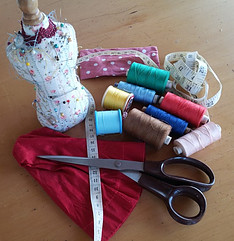
Sewing is one of the oldest textile crafts using a thread and needle to make a stitch. Objects or pieces are attached to one another by using a needle and thread. For thousands of years all sewing was done by hand.
The invention of the sewing machine in the nineteenth century led to mass production of clothing, but hand sewing is still practiced around the world.
When sewing by hand, some tools would be required and these would be fabric, scissors, measuring tape, needles, thread and pins. Sewing larger items like garments would also require a pattern and a sewing machine.
Other sewing tools that would sometimes be required would be seam rippers, marking chalk and a cutting mat. Ironing the seams when sewing a garment is essential so an iron, ironing board and pressing cloth would be needed. 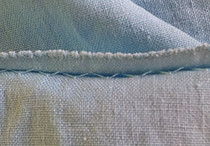
There are numerous stitches that are used in hand sewing, but the basic ones are cross stitch, chain stitch, running stitch, blind stitch, blanket or buttonhole stitch and satin stitch. These stitches are still the fundamental stitches that are used in hand sewing and hand embroidery today.
Hand embroidery and needlepoint are both decorative forms of hand sewing.
The Art of Hand Embroidery
Hand Embroidery is the craft of decorating fabric or other materials using a needle to apply yarn or thread. Other materials such as beads or sequins may also be incorporated in embroidery.  Nowadays it is used as a decorative stitch on garments, household linen and hats, using a variety of colours and stitches.
Nowadays it is used as a decorative stitch on garments, household linen and hats, using a variety of colours and stitches.
When doing hand embroidery, only part of the fabric would be covered with the embroidery pattern. Whereas with needle point, the entire piece of fabric would be covered with yarn.
Many embroidery patterns involve counting the threads to create the design.
The threads in the base fabric can be drawn together and also cut to form the design. Geometric patterns and designs are common in hand embroidery.
Needlepoint uses a similar technique to counted thread embroidery, but the stitches would create a dense pattern that would completely cover the foundation fabric, as in tapestries.
Cross stitch is the stitch that is commonly used in needlepoint.
During the Industrial Revolution embroidery machines were invented and many sewing machines are now available with embroidery functions included. Logos on factory made clothing would be machine embroidered onto the garments.
The Art of Hand Knitting
Hand knitting is the craft using two needle and a yarn or strand to create a fabric or textile. 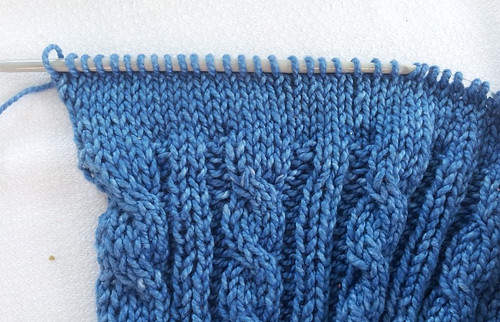 Yarn is used to make multiple loops on the knitting needles, called stitches. So a stitch is a single loop of yarn or thread. Knitting has several active stitches on the needle at any one time, either in a line or tube, forming a row of stitches.
Yarn is used to make multiple loops on the knitting needles, called stitches. So a stitch is a single loop of yarn or thread. Knitting has several active stitches on the needle at any one time, either in a line or tube, forming a row of stitches.
Knitted fabric is made up of interlocking rows of loops. A newly created loop is pulled through one loop from the previous row, placed on the needle, and so new rows are formed.
Casting On and Casting Off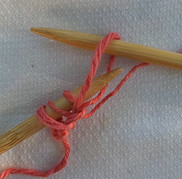
Any piece of hand knitting is started with the process of casting on, which is the creation of the initial stitches onto the needles. Different ways can be used to cast on the stitches, depending on the effect that one wants to have or the use of the article.
Hand knitters use many hundreds of different knitting stitches with the most common one being stocking stitch.
The number of open or active stitches on the needles remains the same as the amount that was cast on. Unless you are increasing (adding) or decreasing (removing) the stitches.
The remaining stitches are cast off when the hand knitted article is finished. 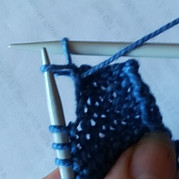 Casting off loops the stitches across each other so that they can be removed from the needles without unraveling the piece.
Casting off loops the stitches across each other so that they can be removed from the needles without unraveling the piece.
When an article like a sweater is knitted, it will have several pieces that need to be sewn together to complete it.
The Two Main Stitches in Knitting
The two main stitches are knit and purl and these two are used to make up many patterns. Stocking stitch is created when each knit row is followed by a purl row and repeated continuously.
Garter stitch is formed when each knit row is followed by another knit row and repeated.
Knit and purl form the basis of many other stitches like rib, moss, cables, making eyelets, seed stitch, triangles and diamonds and many hundreds of other stitch options.
Knitting needles are available in many different sizes to be used with different thickness yarns. Needles can be straight or circular, depending on the article that is being knitted.
To get ideas and inspiration for your hand knitting or crochet project, this is where you will find a great selection of yarn for crafts at affordable prices.
The Art of Hand Crocheting
Crochet comes from the French word crochet which means small hook. 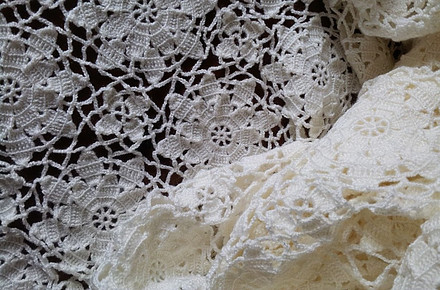
To begin to crochet, a slip-knot loop is placed on the crochet hook. 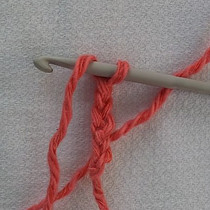 A chain is then formed by pulling another loop through the first loop and repeating this process until the chain is the required length.
A chain is then formed by pulling another loop through the first loop and repeating this process until the chain is the required length.
The chain is either turned and worked in rows, or it can be worked in a circle.
To work in rounds or circles, a single loop is formed by joining the end of the chain to the beginning of the chain with a slip stitch. Stitches are made by pulling one or more loops through each loop of the chain.
There is only one loop left on the hook at the end of each stitch.
Main Types of Basic Crochet Stitches
There are five main types of basic crochet stitches (terminology varies in different countries and these description uses US crochet terminology).
- Chain stitch is the most basic of all stitches and it is used to begin most projects.
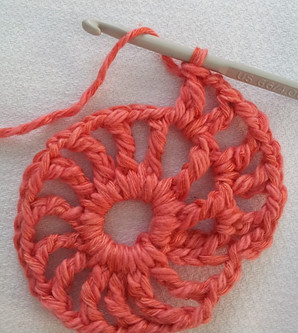
- Slip stitch is used to join chain stitch to form a loop or ring.
- Single crochet stitch (in the UK it is called double crochet stitch) is the easiest stitch to learn.
- Half-double crochet stitch (in the UK it is called half treble stitch and this is the ‘in-between’ stitch.
- Double crochet stitch (called treble stitch in the UK) has many uses and is widely used.
Fabric is created by interlocking loops of thread, yarn or strands of other materials, by using a crochet hook. In crochet each stitch is completed before the next one is begun, whereas in knitting numerous stitches are kept open all the time.
More advanced stitches are usually a combination of basic stitches and these would include the spike stitch, butterfly stitch, shell stitch, popcorn stitch, V stitch, crocodile stitch, cluster stitch, and Afghan stitch.
The basic stitches differ in height and thickness but the same horizontal distance would be covered by all. A crochet hook can be made from metal, wood or plastic and come in many different sizes.
Why do You Want to do Hand Crafts?
There are several benefits of having a handicraft: 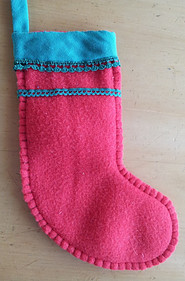
- Hand crafts are environmentally friendly – it uses only your own energy and waste materials are almost zero.
- You can enjoy peace and quiet while gathering your own thoughts.
- Health – some craft projects are intricate which leads to better hand-eye coordination and spatial awareness.
- Mental health – crafting stimulates areas of the brain that can make you happier and it has a therapeutic and calming effect.
- Crafting is sociable and you can do it on your own or get together with other hand crafters and share ideas.
- You learn new skills through doing hand crafts.
- You can create unique pieces, either for yourself or to use as gifts or sell.
The feeling of satisfaction when you have created something with your hands, makes you feel great. Specially when you get compliments about your creations. With the big choice of yarn for crafts that are available, it is easy to get excited about hand crafts and create your own bespoke articles.
Please leave any comments or questions below and I will get back to you.

Hi There,
If you love hand crafts then you will definitely love felted wool crafts. The wool crafts are made with felting process.
Felting process is making raw wool into desired shape by soap water and hand pressure. After the desired shape is done then applied necessary add on like needle felting, stitching and necessary decorations as required by the designer. In all steps during the making, there needs an expert hand or skillful artisans. The products are 100 % wool and handmade. Eco-friendly products made with eco-friendly procedure.
The handmade felt wool products includes ball, shoes & slippers, animal toys, cushion, yoga mat, Christmas hangings, bag, purse etc. and long list of other items designed by creative designers.
Thank you for sharing this great hand craft process. You might find this post on sustainable wool and recycled wool projects interesting.
Hi there, I love your website as it shares great articles to read to learn more about how to live a better life without the need to hurt our planet, I love to sew and I love to read articles about sewing, crocheting and knitting, and I can see there is more and more young people interested to make of them their careers!
Hi there, thank you for your kind comments. It would be good news if the younger generation took up some hand crafts. It is something that I find very fulfilling. All the best, Liné
Hi,
Thanks so much for sharing this post, I don’t think hand crafts is a dying art at all, at least here in Canada people (young and not so young) are working on handmade crafts and make an income from it, I’ve seen wonderful crafts all kind and I’ve seen people love them!
Hi there, I am so pleased to hear that people in Canada are still making handmade crafts and making an income from it. I do think it depends on where one lives as well, as I have seen a lot of crafts and Craft Fairs in South Africa and Australia and love the creativity. I lived in England for many years and was the only one in our circle of friends who did any sewing, knitting or crocheting. I currently live in Italy, and once again hardly ever come across hand crafts. So thanks for sharing your experience. Liné
Awesome article, strike to the point, thanks for sharing
Thank you, I find hand crafts very rewarding and therapeutic
Hand crafts are amazing, My Mother and Grandma are expert in Hand Crocheting, and I learn from them. My Aunt send them a Books of different design and they work on it day by day by day. Back in the days we dont have tv but my grandma have a battery operated radio and she set all day and work on it. Her so call day off is going to the Market and have a haircut, manicure and pedicure and a movie time. And she`s back in here daily routine.
And you have steps to do it. I need to learn the Knitting, And I love cross stich, I have a few projects that I finished but I work a lot so dont have time to do it.
Thank you for creating this website, I love it
Thank you, hand crafts can relax the body and the mind. Hand knitting is very easy to learn so look out for my online course when I post it.
I think hand crafts are going to become more popular, even as technology becomes more advanced.
Many times we need to find ways to unplug from the net and its great if we have a hobby that gets us focused on creating something physical or it might be taking a hike outdoors to clear our mind.
I see my sister and also other family members that want to create something at times with their hands. We get so focused on our TV or computer screen and these hand crafts are a great way to use the other side of our brain.
I really enjoyed your article and it makes me think of things I want to do, away from the net.
The joy with hand crafts is that you can do it while you are chatting to the family. I always knit or crochet while watching TV
Hand craft for me is still the best so far. With them you can make your own design and pattern as you want. These arts are still very much available till date, despite the technological development going on around. Some time age I went on a vacation to Spain and hand made stuffs are still very much in use there. Although they are getting less and less available, I would love this art to be taught in schools ass vocational skill.
I agree with you Dave, if hand crafts can be taught at school again, then an early interest can develop into a passion.
I like your article, I never knew much about hand knitting until I read your section, it is very informative and can benefit people who want to consider hand crafting a hobby or business. My mother used to fix my buttoned shirts with sewing, she made me try it one time and I constantly stabbed my fingers with the needle, that’s when I knew sewing wasn’t for me haha! I’m wondering however can origami be considered hand crafting?
I have taught both my boys how to sew on buttons and they do it in a way that works for them (hahaha) Origami is wonderfully creative and I would think that falls under hand crafts as well.
Thanks for this educative post, I am totally a fan of craftwork and to see that traditional skills is at risk of dying out is sad. Skills such as weaving, forging and soldering are in danger of being lost as demand for them falls in the digital age, I use to do lost of Weaving with my grandma and at that time I actually felt good to make something with my hands alone. This is truly a tradition that needs to be revived.
I have 2 hand looms for weaving and love weaving, so will cover it in another post. Sadly many traditional hand crafts are not taught at school any more. If mom or granny do not show the little ones how to do things, then it gets lost which I do find sad. There is so much joy that can be found in creating something unique by hand
I completely admire people who are really good with handcrafts. I don’t really know much about this area of expertise because I’m not a fan of sewing. The only creative hand work I can do are cross stitching and basic crochet that I learned from my mother. Some of my home decor would include my cross stitched pieces which I put into frames to remind me of my patience and hardwork. Mostly it’s butterfly patterns, and landscapes.
It’s therapeutic for me in a way that it clears my mind off my problems and stress from work. A sense of fulfillment gives me confidence and self esteem whenever I finish a project. I also do this for my family and friends as a gift for special occassions. Do you have new ideas or trends in cross stitching? Thanks for sharing all this wonderful hand crafts that we can do in the comfort of our homes. I believe it’s not dying as long as there are people who promotes it like you do. thank you!
Wow, you do hand embroidery that you frame! That is fantastic. I totally agree with you that doing hand crafts can clear the mind and makes you relax. I personally do a lot of hand knitting and sewing, but not that much hand embroidery at the moment, so will have a closer look at the trends in hand embroidery.
Hand crafts is what I love to do as a kid. This art is a really fun and interesting culture that is gradually. During and should really be taken up in the society. It is a really helpful activity that does not just help and assist the brain to grow but is also used to help boost brain performances of elderly people. A huge interesting part of hand craft is the feeling of satisfaction when you have created something with your hands which makes one feel great, specially when one get compliments about your creations.
Hand crafts and being creative certainly boosts brain activity and self confidence, specially when you get compliments. And that goes for younger people as well, not just the aged
It appears to be a sad fact of life that hand crafts are in fact dying out and it is reading your post here that has made me realise that fact, you see I was born in 1962 so I can remember all of the hand crafts listed in your post, in fact it took me right back to the days of my youth when lots of women were sitting, knitting a jumper or a cardigan, crocheting, sowing or darning socks, sadly we just don’t see these things any more and I do think it is very sad, I also commend you for writing this post and trying to rekindle peoples interest in these old and very interesting hobbies and activities, thank you for sharing.
Hi Russ, I think there was a time when hand crafts were suddenly not seen as “trendy” or “fashionable”, so people stopped doing it and instead focused on TV and social media and their cell phones. I hope that there is a realisation that there is more to life than staring at a screen and that hand crafts are very special indeed.
Tbis is a very good post on hand crafting. Really I didn’t learn hand crafting but I know a bit about sewing this is because my mum sews and knits, she didn’t get a machine for any if these and till now when she feels like having peace, she knits. She says it’s a type of meditation for her and I have to agree when you say it has mental benefits. This is very well detailed on the types of hand crafts and their sub types.
It is never too late to ask your mom to teach you the basics of hand knitting and sewing. It really is not difficult and will always be useful.
Hand craft is a good thing to know of, learning one is a very beneficial thing to do, as it can serve as hobby and even as a source of earning money by offering services out to people in need of it. Hand craft can involve working with leather, textile, it can be embroidery and so on, and it has been passed down from one generation to another. This post have really explained some of the aforementioned hand crafts and they’ll serve as useful guide to aspiring learners. Very educating, I love it.
There are so many other hand crafts that one can try, not just hand embroidery, hand knitting and hand crocheting. Woodwork and leather art are just some of the other hand crafts that I will cover in later posts.